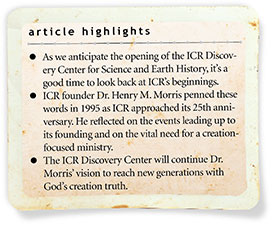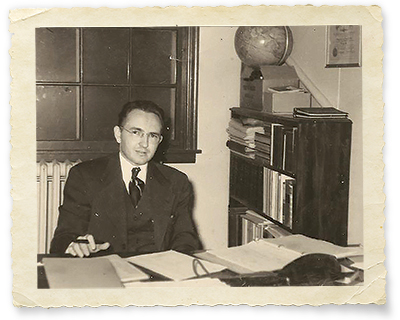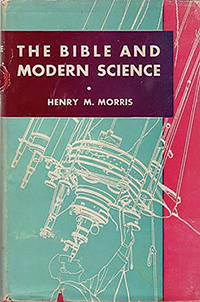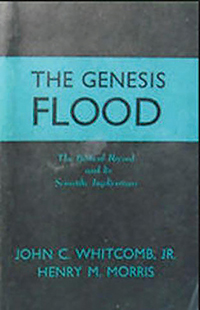 This article sets forth the background and mission of the Institute for Creation Research, as I have envisioned from the start. A key purpose of ICR is to bring the field of education—and then our whole world insofar as possible—back to the foundational truth of special creation and primeval history as revealed in Genesis. The doctrine of special creation is basic in Christianity, and I trust that God has raised up ICR to help meet this need.
This article sets forth the background and mission of the Institute for Creation Research, as I have envisioned from the start. A key purpose of ICR is to bring the field of education—and then our whole world insofar as possible—back to the foundational truth of special creation and primeval history as revealed in Genesis. The doctrine of special creation is basic in Christianity, and I trust that God has raised up ICR to help meet this need.
We expect to celebrate ICR’s 25th anniversary this year (1995–1996). God has greatly blessed the ministry, but the world’s need in relation to the creation message has hardly been touched. Since I am nearing retirement, it’s important for the ICR family to obtain a clear understanding of where we have been and where we are going if we are going to meet effectively the tremendous challenges of the days ahead.
Much of the ICR vision has come out of my earlier study and experience.
There’s still a great need for at least one Christian educational center based on and framed around biblical revelation, especially the foundation of strict creationism.

This dream resulted from 35 years (1935–1970) as a Christian student, teacher, and administrator in five universities, all dominated by an evolutionary humanistic philosophy. Even though such a dream may seem unrealistic, it represents a goal toward which Christians should aim. Today’s young people will be the leaders of tomorrow in every field of human activity. There can be no more vital goal than to provide as many of them as possible with a solid biblical, Christian, creationist education.
I accepted Christ at age 10 through reading a Bible my mother gave me. This was during the Great Depression, but I was able to get into Rice University. Although I was a theistic evolutionist at that time, I could see even then that the teachings in science and the humanities were largely atheistic. I graduated in 1939 with a degree in civil engineering and then worked three years for the International Boundary and Water Commission in El Paso, dealing mostly with studies on the hydrology and hydraulics of river flood control.
 While in El Paso, my wife and I became members of a good church, and I soon joined the Gideons. Through these I became convinced of the power of God’s Word and the importance of winning people to Christ. In 1942, I was asked to return to Rice as an instructor to teach engineering to Navy students who were being trained as officers for the war. By then I was spending much time in the Word and soon started teaching a Bible class for the students. I also began reading every book I could find relative to science and the Bible in order to answer the questions the students raised, especially about evolution and creation.
While in El Paso, my wife and I became members of a good church, and I soon joined the Gideons. Through these I became convinced of the power of God’s Word and the importance of winning people to Christ. In 1942, I was asked to return to Rice as an instructor to teach engineering to Navy students who were being trained as officers for the war. By then I was spending much time in the Word and soon started teaching a Bible class for the students. I also began reading every book I could find relative to science and the Bible in order to answer the questions the students raised, especially about evolution and creation.
There was very little sound creation literature available in those days, so I set out to write a small book myself that would help win skeptical young people to Christ and His Word. That You Might Believe was first published in 1946.
When the war ended, I enrolled in the graduate program at the University of Minnesota, majoring in hydraulics and minoring in geology and mathematics. I’d come to realize that the biblical Flood provided the real key to harmonizing the scientific study of Earth’s history with the Genesis record and thus was the ultimate answer to evolutionism. The combination of hydraulics and geology seemed the best preparation for effectively dealing with the great Flood in relation to science, and the University of Minnesota had the best combination of facilities and faculty for such study.
 I had to take a full-time instructorship to support my family. The Lord led providentially in many ways during those years, enabling me to get both the M.S. and Ph.D. degrees in record time. A new edition of my book was brought out by Moody Press in 1950—The Bible and Modern Science—which is still in print as Science and the Bible. It was evidently the first book written by a scientist on a secular university faculty (at least in the 20th century) that presented evidence for recent creation and Flood geology.
I had to take a full-time instructorship to support my family. The Lord led providentially in many ways during those years, enabling me to get both the M.S. and Ph.D. degrees in record time. A new edition of my book was brought out by Moody Press in 1950—The Bible and Modern Science—which is still in print as Science and the Bible. It was evidently the first book written by a scientist on a secular university faculty (at least in the 20th century) that presented evidence for recent creation and Flood geology.
We then went to Louisiana, where I served six years as Head of the Civil Engineering Department at the University of Southwestern Louisiana. I continued the library research and study I’d begun at Minnesota on geology and the biblical Flood, writing several chapters on what I hoped might become a definitive work on biblical creationism and catastrophism. In 1953, I met Dr. John Whitcomb at a meeting of the American Scientific Affiliation (ASA) in Indiana. He’d read That You Might Believe as a student at Princeton University and was one of the very few men at that ASA meeting who agreed with a paper I presented there titled “Biblical Evidence for Recent Creation and the Worldwide Deluge.”
I had thought that since these ASA scientists and theologians professed to believe in the inspiration of Scripture, they would accept literal creationism and the worldwide Flood if they could just be shown that this is what the Bible teaches.
I was wrong. In the question period, they raised numerous scientific objections but not one answer to the biblical evidence that was absolutely compelling.
That experience has been repeated many times since. The reaction to strict creationism by Christian evolutionists and progressive creationists is almost invariably to defer to “science” rather than Scripture. They feel Christians should interpret Scripture to conform to current scientific opinion rather than interpret the scientific data in the context of biblical revelation.
Such an attitude in anyone who professes to be a Christian is dishonoring to God’s Word and to the Lord Jesus Christ, who Himself believed in recent creation and the worldwide deluge.
There has been a remarkable revival of creationism in the past three decades. The Scopes Trial in 1925 resulted in such an overwhelming media victory for the evolutionists that Christians as a whole seemed to want to ignore the entire controversial subject of origins.
They no longer dared to question the evolutionary ages of the geologists, and many Bible teachers tried to insert these ages into a postulated “gap” between the first two verses of Genesis. Geologists, of course, could never accept this gap theory because their “ages” were based on the assumption of uniformitarianism, which has no room for the global pre-Adamic cataclysm required by any such theory. The scientific and educational worlds gravitated to total evolutionism, while Christians concentrated on “personal Christianity.”
At the great Darwinian Convocation at the University of Chicago in 1959, gathered to celebrate the 100th anniversary of Darwin’s Origin of Species, evolutionists from all over the world paid homage to Darwin, eulogizing him for delivering the world out of what they thought was biblical bondage into evolutionary freedom. The keynote speaker, Sir Julian Huxley, proclaimed the complete triumph of evolutionary humanism, and other speakers urged the schools henceforth to center their curricula around the “fact” of evolution.
 It was at that very time that John Whitcomb and I were writing The Genesis Flood. Published early in 1961, the Lord graciously used it as a catalyst to stir up the modern creationist revival. There had been a few attempts earlier to establish an organized witness for scientific creationism, but these had floundered. The failure was caused by divisive arguments between strict creationists and those who wanted to accommodate the geological ages in their systems.
It was at that very time that John Whitcomb and I were writing The Genesis Flood. Published early in 1961, the Lord graciously used it as a catalyst to stir up the modern creationist revival. There had been a few attempts earlier to establish an organized witness for scientific creationism, but these had floundered. The failure was caused by divisive arguments between strict creationists and those who wanted to accommodate the geological ages in their systems.
These two systems are like oil and water; they will never mix because they are founded on two different premises. One believes Scripture should govern our interpretation of scientific data; the other believes current scientific majority opinion should control our interpretation of Scripture. Neither evolution nor creation can be scientifically proved since they are dealing with history instead of repeatable science. It’s possible to build a case for either view, and the decision finally boils down to what one wants to believe.
We who believe in a recent, six-day, literal creation of all things believe that Christians ought to take God at His Word and allow the Bible to say what its writers, guided by the Holy Spirit, intended it to say. When one holds this high view of Scripture, one must accept Genesis at face value. This not only means six normal 24-hour days of creation but also no geological ages, and that’s the pill many Christians refuse to swallow. The Scriptures clearly teach that there was a global and cataclysmic flood. This can only mean that the Flood and its aftereffects must explain most of the stratigraphic and fossil evidences commonly found in Earth’s crust.
This is what The Genesis Flood tried to show, and it soon found acceptance by many scientists and others who, like John Whitcomb and myself, wanted to take God’s Word as divinely inspired and easily understood by anyone willing to believe it.
Two years later, in 1963, the Creation Research Society (CRS) was formed. The time was ripe to establish a society of scientists who were strict creationists and who would do their research in the light of biblical creationism.
The American Scientific Affiliation (ASA) had been organized in 1941, ostensibly to oppose evolution, but it also was soon divided into two camps—those who wanted to accommodate the geological ages and those who did not. The progressive creationists and theistic evolutionists had gained almost complete control of the ASA, and this was another stimulus for forming the Creation Research Society.
Beginning with only 10 scientists, CRS grew rapidly and currently has a membership of hundreds of scientists with post-graduate degrees, all committed to strict creationism and Flood geology.
I had resigned in 1957 from my job as Head of Civil Engineering at the University of Southwestern Louisiana and then taken a similar appointment at Virginia Tech. Although we had six children, the Lord wonderfully provided our needs everywhere we went (six states, nine jobs). We learned to live simply and frugally and have tried to apply these same principles on an organizational level at ICR.
 At Virginia Tech, God greatly blessed. Our Civil Engineering Department grew to be the third-largest in the nation, with a strong Ph.D. program and the second-largest research program at the university. My textbook on applied hydraulics and water resources was published in 1963.
At Virginia Tech, God greatly blessed. Our Civil Engineering Department grew to be the third-largest in the nation, with a strong Ph.D. program and the second-largest research program at the university. My textbook on applied hydraulics and water resources was published in 1963.
I think the most important event during those years at Virginia Tech, however, was the publication of The Genesis Flood. Not only did this catalyze the modern creationism revival, but it also drastically changed my own life!
I began to get speaking invitations all over the country. For a while I tried to accept them all, but this eventually became impossible. I was also writing other books and articles, and all of this became practically a full-time job in addition to my teaching and administrative job at the university—not to mention family responsibilities.
The Lord used these extracurricular activities to lead us to California to start our full-time creation ministry. Much of my speaking had been at Christian colleges, seminaries, and churches, and these had greatly increased my awareness of the urgent need for creation teaching even in Christian institutions, not to mention the pervasive dominance of evolutionism in secular schools.
Accordingly, in September 1970 I resigned from Virginia Tech and accepted the invitation from Dr. Tim LaHaye to move to San Diego, where we proposed to start a creation-oriented Christian liberal arts college with an associated center for creation research and extension ministry. This center became the Institute for Creation Research.
Adapted from Dr. Morris’ Back to Genesis articles in the July and August 1995 issues of Acts & Facts.
* Dr. Henry M. Morris (1918-2006) was Founder of ICR.




